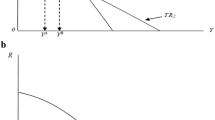Abstract
The present paper provides an analysis of unfunded social securityas the outcome of a public decision making process in an endogenousgrowth economy. It employs a model in which there is a non-monotonic relationship beween productivity growth and the scale ofpublic intergenerational redistribution. The paper shows thatalthough unfunded social security need not harm growth in general,it is likely to harm growth in a democracy. This effect isreinforced by population aging.
Similar content being viewed by others
References
Aaron, H.J. (1966). The social insurance paradox. Canadian Journal of Economics and Political Science 32: 371-376.
Abel, A.B., Mankiw, N.G., Summers, L.H. and Zeckhauser, R.J. (1989). Assessing dynamic inefficiency: Theory and evidence. Review of Economic Studies 56: 1-20.
Arrow, K.J. (1962). The economic implication of learning by doing. Review of Economic Studies 29: 155-173.
Becker, G.S. and Barro, R.J. (1988). A reformulation of the economic theory of fertility. Quarterly Journal of Economics 103: 1-25.
Boadway, R.W. and Wildasin, D.E. (1989). A median voter model of social security. International Economic Review 30: 307-328.
Breyer, F. (1994). The political economy of intergenerational redistribution. European Journal of Political Economy 10: 61-84.
Browning, E.K. (1975). Why the social insurance budget is too large in a democracy. Economic Inquiry 16: 373-388.
Cabellero, R. and Lyons, R. (1990). Internal versus external economies in European industry. European Economic Review 34: 805-826.
Carmichael, J. (1982). On Barro's theorem of debt neutrality: The irrelevance of net wealth. American Economic Review 72: 202-213.
Cigno, R. and Rosati, F.C. (1996). Jointly determined saving and fertility behavior: Theory, and estimates for Germany, Italy, UK and USA. European Economic Review 40: 1561-1589.
Diamond, P. (1965). National debt in a neoclassical growth model. American Economic Review 55: 1126-1150.
Downs, A. (1957). An economic theory of democracy. New York: Harper & Brothers Publishers.
Ehrlich, I. and Lui, F.T. (1991). Intergenerational trade, longevity, and economic growth. Journal of Political Economy 99: 1029-1059.
Grossman, G.G. and Yanagawa, N. (1993). Asset bubbles and endogenous growth. Journal of Monetary Economics 31: 3-19.
Hansson, I. and Stuart, C. (1989). Social security as trade among living generations. American Economic Review 79: 1182-1195.
Jones, L.E. and Manuelli, R.E. (1992). Finite lifetimes and growth. Journal of Economic Theory 58: 171-197.
Kimball, M.S. (1987). Making sense of two-sided altruism. Journal of Monetary Economics 20: 301-326.
King, I. and Ferguson, D. (1993). Dynamic inefficiency, endogenous growth, and Ponzi games. Journal of Monetary Economics 32: 79-104.
Romer, P.M. (1986). Increasing returns and long-run growth. Journal of Political Economy 94: 1002-1037.
Romer, P.M. (1989). Capital accumulation in the theory of long-run growth. In R. Barro (Ed.), Business cycle theory. Cambridge, MA: Harvard University Press.
Saint-Paul, G. (1992). Fiscal policy in an endogenous growth model. Quarterly Journal of Economics 106: 1243-1259.
Samuelson, P.A. (1958). An exact consumption-loan model of interest with or without the social contrivance of money. Journal of Political Economy 66: 467-482.
Townley, O.G.C. (1981). Public choice and the social insurance paradox: A note. Canadian Journal of Economics 14: 712-717.
Verbon, H.A.A. (1987). The rise and evolution of public pension systems. Public Choice 52: 75-100.
Verbon, H.A.A. and Verhoeven, M.J.M. (1992). Decision making on pension schemes under rational expectations. Journal of Economics 56: 71-97.
Weizsäcker, R.K. von (1990). Population aging and social security: A politico-economic model of state pension financing. Public Finance 45: 491-509.
Wigger, B.U. (1998). Pay-as-you-go financed public pensions in a model of endogenous growth and fertility.Journal of Population Economics, forthcoming.
Zhang, Jic. (1995). Social security and endogenous growth. Journal of Public Economics 58: 185-213.
Zhang, Junxi. (1995). Does unfunded social security also depress output growth? Economic Letters 49: 307-312.
Zhang, Junsen and Nishimura, K. (1993). The old-age security hypothesis revisited. Journal of Development Economics 41: 191-202.
Zhang, Junsen and Zhang, Junxi. (1995). The effects of social security on population and output growth. Southern Economic Journal 62: 440-450.
Author information
Authors and Affiliations
Rights and permissions
About this article
Cite this article
Wigger, B.U. Productivity Growth and the Political Economy of Social Security. Public Choice 106, 53–76 (2001). https://doi.org/10.1023/A:1005118601448
Issue Date:
DOI: https://doi.org/10.1023/A:1005118601448




